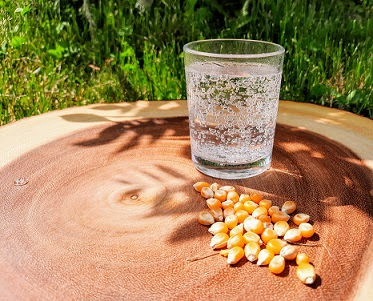Dancing Popcorn is a popular STEM experiment among teachers of young
children. It requires only three materials, is easy to prepare and clean
up, and can be used to teach a variety of science concepts such as:
- buoyancy, sink, float
- density
- states of matter (solids, liquids, and gases)
- chemical changes
- making and confirming predictions
- vocabulary development: carbon dioxide
There are two ways to do the Dancing Popcorn STEM experiment, one using
seltzer water and the other using vinegar and baking soda. This blog
post is going to focus on the easier of the two... dropping popcorn
kernels into seltzer water. Keep reading to learn more about this
experiment and how you can use it with your little ones.
Disclosure: Affiliate links to Amazon are included in this post.
Dancing Popcorn STEM Experiment
This project is similar to the Dancing Raisins STEM activity that many teachers use in their classrooms. If you'd like, you can swap out the kernels and use raisins instead... the results and process will be the same and the activity will be just as fun! The materials for this STEM activity can be found in your kitchen or purchased inexpensively from a dollar store.Question
What happens when I drop popcorn kernels into a glass of seltzer water?
Hypothesis / Prediction
I think the popcorn kernels will _______________ (Insert student's
prediction here.).
Materials
- popcorn kernels (not microwave popcorn)
- seltzer water or clear carbonated soda
- clear glass or cup
Directions
- Pour some seltzer water into the glass. Exact amounts aren't needed.
- Drop 10 popcorn kernels into the seltzer water one at a time.
- Observe.
Additional Questions
- What happens if I drop all 10 popcorn kernels into the seltzer water at once?
- What happens if I drop more than 10 popcorn kernels into the seltzer water?
- What happens if I stir the seltzer water with the popcorn kernels in it?
Results
The popcorn kernels rise to the surface of the seltzer water, fall to the
bottom of the glass, then float up again. They look like they are
dancing!

Conclusion
The popcorn kernels fall to the bottom of the glass because they have more
density than the seltzer water. When the bubbles of carbon dioxide in
the seltzer water attach themselves to the popcorn kernels, the popcorn
kernels become more buoyant and float to the surface. Once the popcorn
kernels reach the surface, the carbon dioxide in the bubbles is released into
the air, causing the popcorn kernels to drop back to the bottom... starting
the cycle all over again.
Did you enjoy reading about the Dancing Popcorn Science Experiment? If
so, check out these blog posts for more science and STEM experiments:
- STEM: Straw Bridge STEM Challenge
- STEM: Pepper and Soap STEM Experiment
- Book + STEM: Dragon's Breath by Michael Gordon + Dippin' Dandelions STEM Challenge
- Book + STEM: The Night Before St. Patrick's Day by Natasha Wing + Leprechaun Traps
- STEM: Hot Chocolate Surprise + STEM Activity
- STEM: Dippin' Dandelions STEM Challenge





